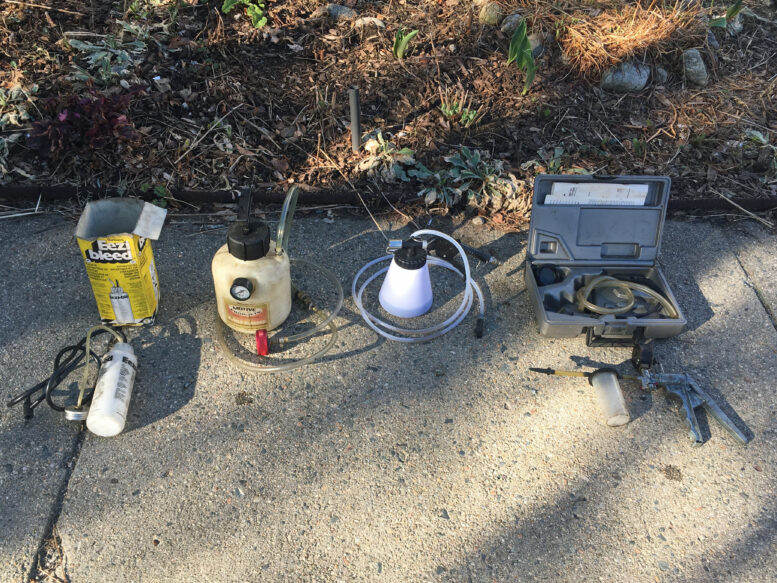If you own a car long enough, its brakes will need to be bled. You could be a goody-two-shoes and be following manufacturer’s recommendation to change the brake fluid every three years or 30,000 miles (which basically no one does), but the need to bleed usually comes when air has been introduced into the brake hydraulics because the system has been opened during a repair such as replacing a caliper or the flexible hoses that lead to it. Or you could be planning on doing a high-performance driving event, in which case changing the brake fluid gains importance because hydraulic braking works on the principle that fluid is incompressible. Brake fluid attracts water, and if the braking system gets very hot, water can boil and turn to steam. Steam, of course, is a gas, which definitely is compressible, likely resulting in the pedal going to the floor. Or you could’ve just bought a long-sitting car whose brake fluid is clearly discolored. Whatever the reason, you’re going to need some sort of method to push or pull the fluid through the system.
In theory, brake bleeding is simple. There’s a bleed valve at each wheel. Cars with disc brakes have the bleed valves on the calipers. On newer cars with single-piston calipers, there’s typically one bleed valve per caliper, but on old cars with multi-piston calipers, there may be multiple bleed valves that need to be opened in a certain order (on vintage BMWs, that’s top-inner-outer). On drum brakes, the bleed valves are located on the backs of the wheel cylinders. You go to one wheel at a time, generally starting with the wheel furthest from the master cylinder and working your way inward, though it’s always best to check the manufacturer’s instructions. You take a plastic or rubber hose, put it over the bleed valve, use a small wrench to open the valve up, run a bunch of fluid through the valve into a container to catch the fluid, close the valve, add fluid to the reservoir because if you let it run dry you’ll introduce a lot of air into the system, then move on to the next wheel. Although the bleed valves can sometimes be reached from behind the wheels, unless you’re working on a car with oodles of ground clearance, it’s generally easier to jack up the back of the car, set it down on stands, pull both wheels, bleed the right rear, then the left, stick the wheels back on, set it back down, then move to the front.
The key part of this is “running a bunch of fluid through the bleed valve.” This is done either by pushing fluid through the system via pressurization (either artificial or via the brake pedal), or pulling fluid by applying a vacuum. There’s also “gravity-bleeding” that tries to just let nature take its course. I’ll talk about all three, but pushing fluid is generally best, and has the added benefit that, if your catch bottle is clear glass or plastic, and if the bleed hose is submerged in the accumulated fluid, you can see air bubbles as they come out and shut the bleed valve after the bubbles stop. If you can’t see the bubbles, or if you’re using one of the suction methods, you typically count a fixed number of seconds or pump the brake pedal a fixed number of times.
Preferred Pressure Method: The Power Bleeder
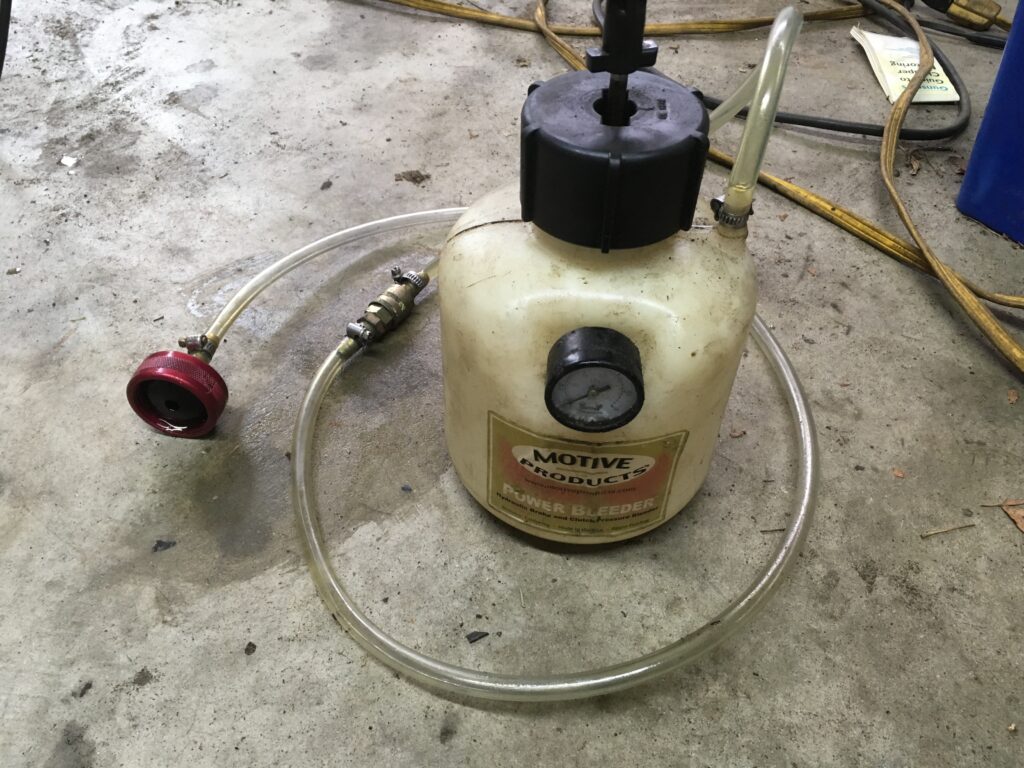
The marriage-saving Motive power bleeder.
Back in the old days, brake bleeding meant roping a spouse or friend into sitting in the driver’s seat and pumping the brake pedal. However, about twenty years ago, consumer-quality power-bleeding tools became widely available. These typically have a big reservoir to hold brake fluid, a cap that attaches to the small reservoir in your car, a hose connecting the two to transfer pressurized fluid, and a T-handle that lets you pump up the pressure, making them look a bit like a garden sprayer. One of the most popular is the Motive power bleeder. These are available on Amazon for about $60, or about $100 if you opt for the one with the nice knurled aluminum cap and the quick-disconnect fitting that allows the cap to be easily swapped for a different one. I bought mine maybe twelve years ago and wonder how I ever lived without it. You don’t need to rope anyone into helping you, you can do it all by yourself at any hour, and it automatically keeps the car’s brake reservoir topped up. Pour a bunch of fresh brake fluid into it, screw its cap onto the car’s brake reservoir, pump it up to 10 or 15 psi, go to the first wheel, open up the bleed valve, watch for bubbles or count to 30, move onto the next wheel. If you fill it with a sufficient amount of brake fluid, you don’t need to attend to it as you move from wheel to wheel.
There are only two real downsides. The first is that if you have a rare car, finding a cap that fits your brake reservoir may be a non-trivial issue (I never one that worked on the stock Girling reservoir on my Lotus Europa). The second is that if there’s a leak anywhere, it can cause a lot of brake fluid to get onto your car’s painted surfaces of the car very quickly. Brake fluid damages paint, so this is to be avoided. Note that, for this reason, some people intentionally don’t fill the Motive with brake fluid and use it only to pressurize the car’s fluid reservoir, then watch the reservoir level, unscrew the cap, and manually refill it before moving to the next wheel. That works, but I think it deprives you of a lot of the efficiency of the Motive.
Anachronistic Pressure Method: Gunson’s Eezibleed
Over 30 years ago, Gunson’s sent me an Eezibleed (yes, that’s how they spell it) for me to review in Roundel magazine. It’s a simple pressure-bleeder without a fluid reservoir, so you need to keep unscrewing it and topping off the fluid in the car. And you don’t manually pump it up—its source of pressure is that you connect its air hose to the tire of the wheel whose brakes are being bled. This works okay if you only need to do a small amount of bleeding, but if you need to run a lot of fluid through a caliper or brake line, you need to inflate the tire back up to pressure afterwards. I used the Eezibleed for years, and the product is still available and comes with several different caps, but I think that most folks would be happier spending another $15 to get the Motive with its fluid reservoir and non-tire-deflating pump. Still, if I was finishing a brake job, the Motive died, and I needed to get the car out of my garage and across the finish line, I’d pull the, ahem, Eezibleed down off the shelf and press it back into service.

An old friend in the garage.
Backup Pressure Method: Someone’s Right Foot
If you don’t have a power bleeder, it’s usually time to go old school and have someone pump the brake pedal. When you do it this way, you need to take the wrench, open up the valve, say “down,” have the helper push the brake pedal about halfway down (you don’t want the pistons in the master cylinder to move further than they usually do), have them hold in that position while you tighten the valve, then say “up” while they lift off the pedal to prevent air from getting sucked back in through the bleed valve. The only real advantage to this method is that it costs nothing. The disadvantages are using up your spouse/friend favors, and the possibility of air getting sucked back into the line either by bad timing or by the pulsating nature of the pumping itself.

Hand on the wrench while someone pumps.
Adjunct to Either Pressure Method: Speed Bleeders
I became acquainted with Speed Bleeders only recently. A few years ago I was having trouble bleeding the brakes on the Lotus. As I mentioned above, no compatible adapter cap was available for the Motive, and trying to make one led to a brake fluid tsunami. Speed Bleeders are the best-known examples of a bleed valve with a little one-way ball check valve in it so you can pump the pedal yourself. The check valve prevents air from getting sucked in when you lift off the pedal, thus enabling one-person pedal-pumping bleeding—no helper needed. In theory, you go to each wheel, remove the bleed valve, replace it with a Speed Bleeder, connect the hose and run it into the catch bottle, crack open the Speed Bleeder, pump the pedal N times, then close the valve. This didn’t solve the soft pedal on the Lotus, but when later I replaced the Lotus’ brake reservoir with one from a 2002 that worked with my Motive, the belt-and-suspenders-and-duct-tape combination of the Motive, the Speed Bleeders, and pumping the pedal was the only thing that fully bled the system.
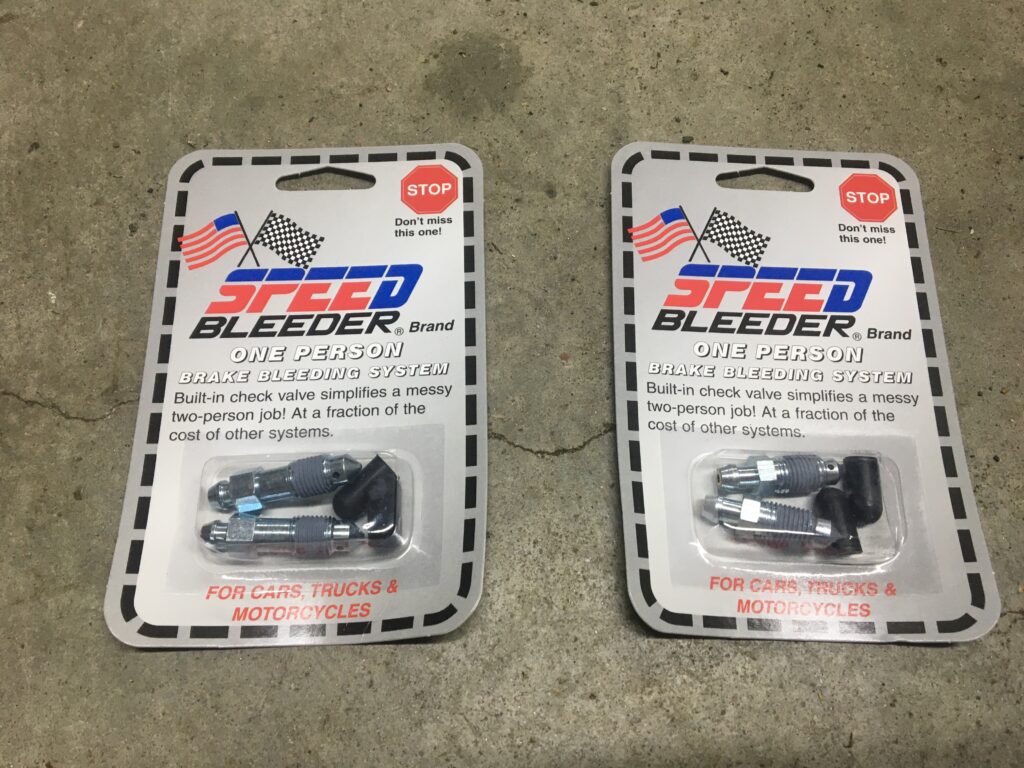
Speed Bleeders to the rescue. Sort of.
Vacuum Methods
The sole advantage of “suck the brake fluid out the bleed valve” vacuum bleeders is that an adapter to the car’s brake fluid reservoir isn’t necessary. Let me say right out that my experience is that vacuum bleeders don’t work nearly as well as pressure-based methods due to air being pulled past the threads once the bleed valve is loosened. This was true for both the old-school pistol-grip-hand-cramp-generating-style unit I’ve owned for decades as well as a new vacuum bleeder that used a feed from an air compressor to pull a vacuum. I gave the new air compressor-based sucker a try when I had the no-power-bleeder-will-fit-the-cap problem on the Lotus, but the thing didn’t pull enough fluid to be useful, and I returned it to Amazon.
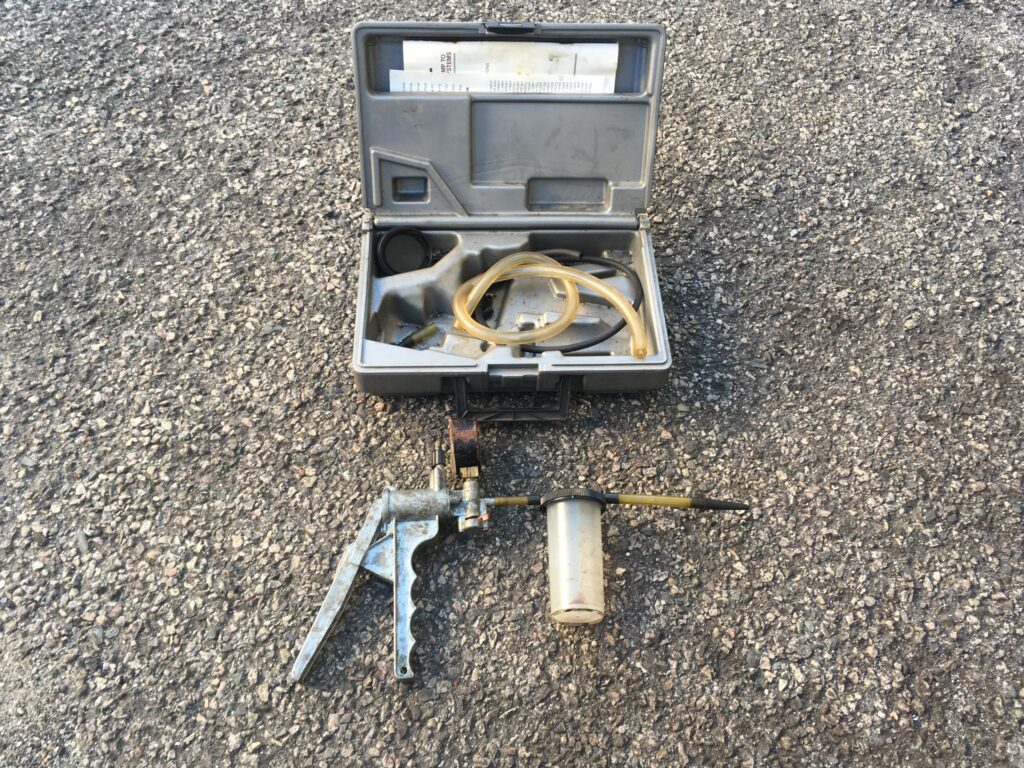
Old unsatisfying hand-squeeze vacuum bleeder.
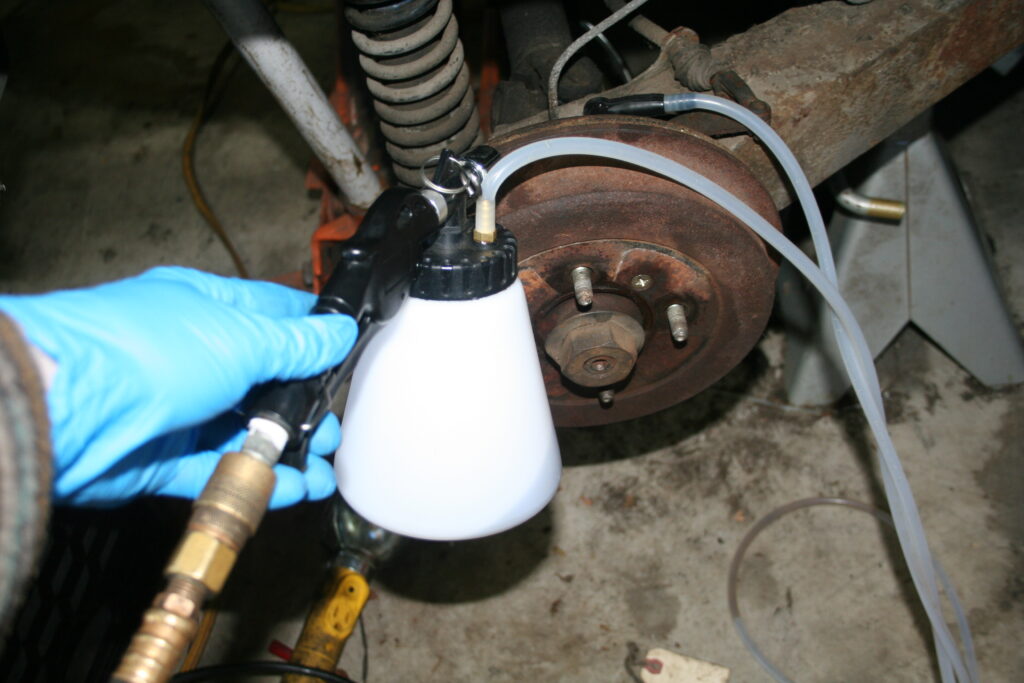
New unsatisfying compressor-powered vacuum power bleeder.
Gravity Bleeding
Gravity bleeding is what it sounds like—relying on the fact that the caliper or wheel cylinder is lower than all the plumbing feeding it, and thus will allow fluid to simply flow out the bleed valve. I’ve always been inherently suspect about this, as a) there’s often an uphill section so it simply doesn’t work, and b) if there’s air in the line, it can interrupt the fluid’s ability to set up a siphon and pull itself out. However, I recently replaced a front brake caliper on my son Aaron’s 2008 Corolla, realized I didn’t have an adapter to connect my Motive power bleeder to its brake reservoir, and before I tried the Eezibleed or pressed the rarely-productive pistol-grip sucker back into service, I thought I’d try gravity-bleeding. It worked flawlessly, to which I credit the caliper’s single-piston design and the fact that I left the old caliper hanging and disconnected its brake hose only when the new caliper was installed, thus minimizing the amount of air that got into the brake hose.
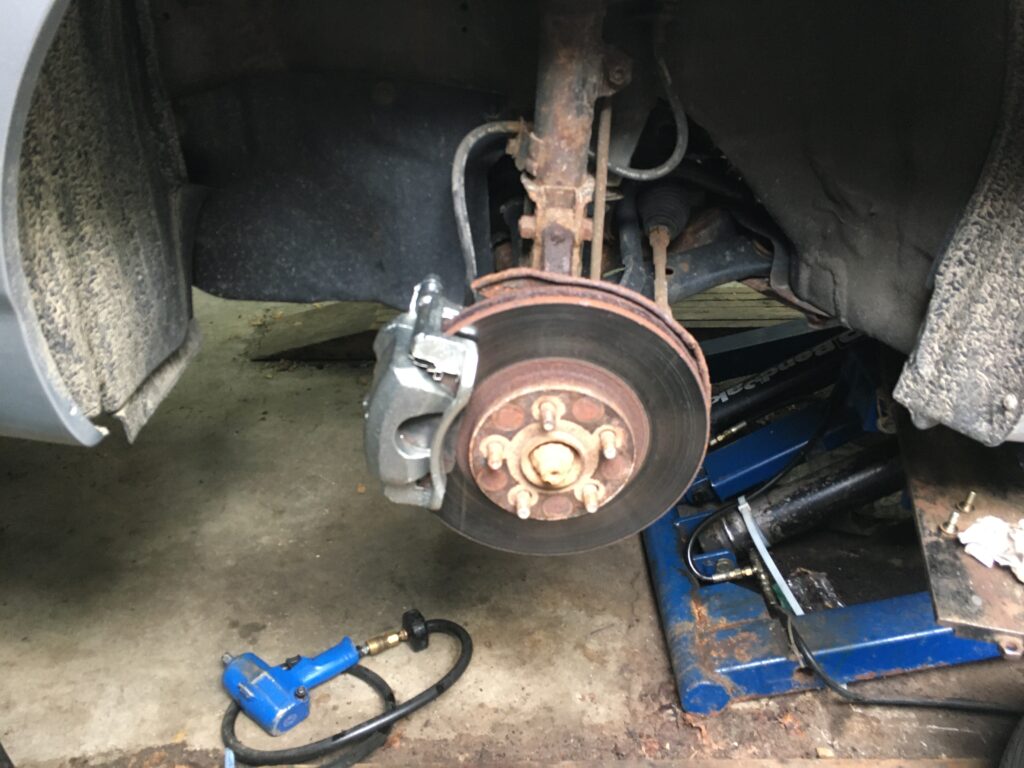
On the Corolla, gravity bleeding for the win.
So yeah, ironically, it was successfully not using a brake bleeding tool that caused me to give you an overview of brake bleeding tools. But if you do a fair amount of wrenching, the short answer is still to buy the Motive power bleeder or something similar.
Two final notes regarding changing icky brake fluid on a long-dormant car. First, if the fluid in the reservoir is black, the best thing to do is not push or pull it through the system at all. Take a turkey baster and suck out as much as you can before filling the reservoir with clean fluid. Second, resist the temptation to fill the Motive with air and bleed each wheel until fluid stops coming out so you “know you got all the old stuff out.” It’s not necessary—it’s usually pretty obvious from the change in color when new fluid is displacing old. More importantly, it is a lot more difficult to bleed a system that’s been completely drained of fluid. Don’t do it unless you’re doing a restoration where all the hydraulics—master cylinder, brake lines, everything—are coming off and on at once.
As The Rolling Stones said on my favorite of their albums, Let It Bleed.
—Rob Siegel
____________________________________
Rob’s newest book, The Best of The Hack Mechanic, is available here on Amazon, as are his seven other books. Signed copies can be ordered directly from Rob here.

